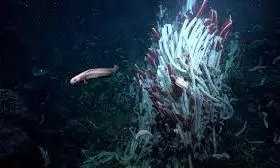
Newly discovered underground marine life challenges understanding of ocean ecosystems
text_fieldsA recent expedition into the depths of the Pacific Ocean has unveiled a remarkable discovery of animal life inhabiting underground cavities near hydrothermal vents.
Led by marine biologist Sabine Gollner and a team from the Royal Netherlands Institute for Sea Research, researchers utilized a deep-diving robot named SuBastian to explore the East Pacific Rise, a region where two tectonic plates meet and separate.
Their exploration revealed previously unknown ecosystems hidden beneath the seabed, teeming with giant tubeworms, snails, and bristle worms.
The study demonstrated that the unique ecosystem associated with hydrothermal vents extends below the ocean floor. These vents, which release superheated, mineral-rich water, create ideal conditions for certain marine species.
Among these, giant tubeworms can reach lengths of up to 10 feet and thrive in these extreme environments. Interestingly, tubeworms do not consume food as other animals do; instead, they rely on symbiotic bacteria that convert sulfur from the vent water into energy.
The research team employed robotic arms with chisels to excavate volcanic rock, uncovering warm, fluid-filled cavities beneath the lava plates. These underground habitats serve as a refuge for marine life and suggest that larvae from seafloor organisms might migrate into these spaces, thereby linking surface and subsurface ecosystems.
According to Gollner, this discovery significantly enhances our understanding of the interconnectedness of marine ecosystems, revealing a more complex web of life that extends beyond the ocean floor.
This finding contributes to the expanding knowledge of organisms thriving in extreme conditions, emphasizing the resilience and adaptability of marine life in the deep ocean.






















